Experimental Test-beds
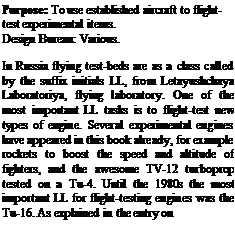
 sors and loggers, computers, oscilloscopes and many kinds ofinstrumentation, overseen by a test and research crew which usually numbers five. The flight crew typically numbers three. Among the engines tested are the NK-86, D-18T and PS-90A turbofans, and the D-236 and NK-93 propfans. One of the photographs shows a former IL-76M used for testing large turbofans of the D-18 family. The other shows a former civil IL-76T used to test the TV7-117S turboprop and its six-blade Stupino SV-34 propeller. The propeller blades are heavily strain-gauged, the instrumentation cable being led forward from the tip of the spinner.
sors and loggers, computers, oscilloscopes and many kinds ofinstrumentation, overseen by a test and research crew which usually numbers five. The flight crew typically numbers three. Among the engines tested are the NK-86, D-18T and PS-90A turbofans, and the D-236 and NK-93 propfans. One of the photographs shows a former IL-76M used for testing large turbofans of the D-18 family. The other shows a former civil IL-76T used to test the TV7-117S turboprop and its six-blade Stupino SV-34 propeller. The propeller blades are heavily strain-gauged, the instrumentation cable being led forward from the tip of the spinner.
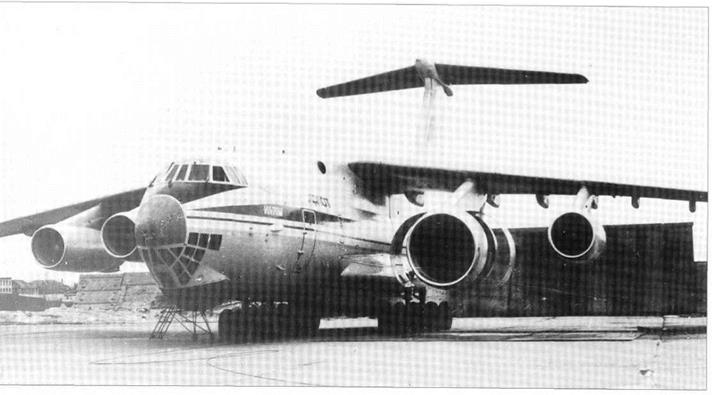
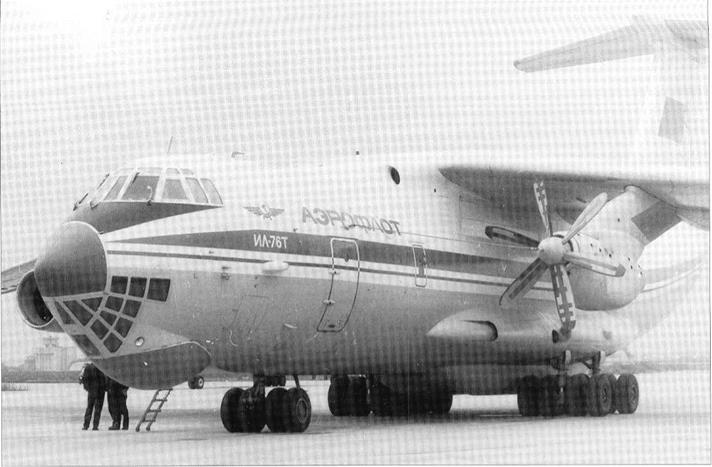

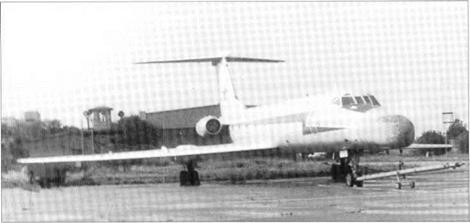
Another Ilyushin aircraft used in significant numbers as an experimental test-bed is the IL-18. Possibly as many as 30 have been used, mainly at the Zhukovskii and Pushkin test centres, for upwards of 50 test programmes. Nearly all are basically of the IL-18D type, powered by four 4,250hp AI-20M turboprops. The most famous ofthese aircraft is the IL-18 No75442, named Tsyklon (cyclone). Instantly recognisable from its nose boom like a jousting lance, this meteorological research aircraft is equipped with something in excess of 30 sensors used to gether data about atmospheric temperature, pressure and pressure gradient, humidity, liquid and solid particulate matter (including measurement of droplet and particle sizes) and various other factors which very according to the mission. The sensors extend from nose to tail and from tip to tip. Other IL-18 and IL-18D aircraft have helped to develop every kind of radar from fighter nosecones to giant SLARs (slide-looking airborne radar) and special mapping and SAR (synthetic-array radar) installations.
Top: IL-76LL with TV7-1 ITS Centre: Nose of IL-18 Tsyklon Bottom: Tu-134 radar testbed
Opposite page, bottom: IL-76LL with D-18T
A small number based at Pushkin tested the main radars and pointed radomes of supersonic aircraft, though this was done mainly by the Tu-134.
Total production of the Tu-134 passenger twin-jet was 853. Of course, the majority were delivered to Aeroflot and foreign customers, but a few went to the WS. From the mid – 1970s aircraft built as passenger transports began to be converted for use as military crewtrainers, including the Tu-134BUformil – itary and civil pilots to Cat IIIA (autoland) standard, Tu-134Sh for navigators and visual bomb aimers (actually dropping bombs to FAB-250 (551 Ib) size), Tu-134BSh for Tu-22M
|
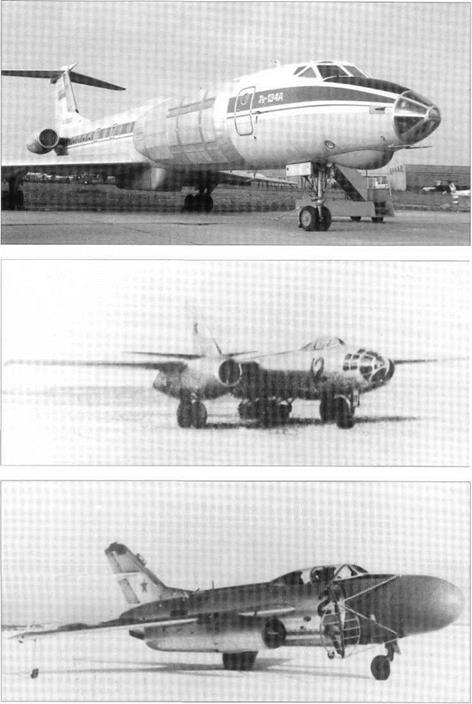 navigators andbomb-aimers, and Tu-134UBL for Tu-16 0 pilots. These are not experimental, nor is the Tu-134SKh with comprehensive navaids and avionics for worldwide land-use and economic survey. On the other hand at least 15 aircraft were converted for equipment testing and research. One has flown over 6,000 hours investigating the behaviour of equipment and Cosmonauts underweightless (zero-g) conditions. Several have been fitted with nose radars under development for other aircraft, including the installations for the Tu-144, Tu-160 and MiG-29. With the designation IMARK, aircraft 65906 has tested the Zemai polarized mapping radar able to operate on wavelengths of4, 23, 68 or 230cm (from Am to 7ft 7in). Arrays ofantennas look down and to the right side from the starboard side of the fuselage and a large ventral container. A generally similar but more versatile test aircraft is 65908. This is based at Zhukovskii together with a Tu-134 fitted with a giant parachute in the tail for emergency use during potentially dangerous research into deep-stall phenomena, which caused the loss of several aircraft with T-tails and aft-mounted engines.
navigators andbomb-aimers, and Tu-134UBL for Tu-16 0 pilots. These are not experimental, nor is the Tu-134SKh with comprehensive navaids and avionics for worldwide land-use and economic survey. On the other hand at least 15 aircraft were converted for equipment testing and research. One has flown over 6,000 hours investigating the behaviour of equipment and Cosmonauts underweightless (zero-g) conditions. Several have been fitted with nose radars under development for other aircraft, including the installations for the Tu-144, Tu-160 and MiG-29. With the designation IMARK, aircraft 65906 has tested the Zemai polarized mapping radar able to operate on wavelengths of4, 23, 68 or 230cm (from Am to 7ft 7in). Arrays ofantennas look down and to the right side from the starboard side of the fuselage and a large ventral container. A generally similar but more versatile test aircraft is 65908. This is based at Zhukovskii together with a Tu-134 fitted with a giant parachute in the tail for emergency use during potentially dangerous research into deep-stall phenomena, which caused the loss of several aircraft with T-tails and aft-mounted engines.
Photographs show two other aircraft from the many hundreds used in the former Soviet Union for special tests. One shows an IL-28 used for research into the design, materials and behaviour of skis on different kinds of surface. A large ski mounted under the bomb bay near the centre of gravity could be rammed down against the ground by hydraulic jacks. On the ski were test shoes of different sizes, shapes and materials. The other photograph shows the Yak-25 test-bed fitted on the starboard side with the engine installation proposed for the Yak-28, with a sharp lip and moving central cone. Ahead of it was a water spray rig for icing trials.











